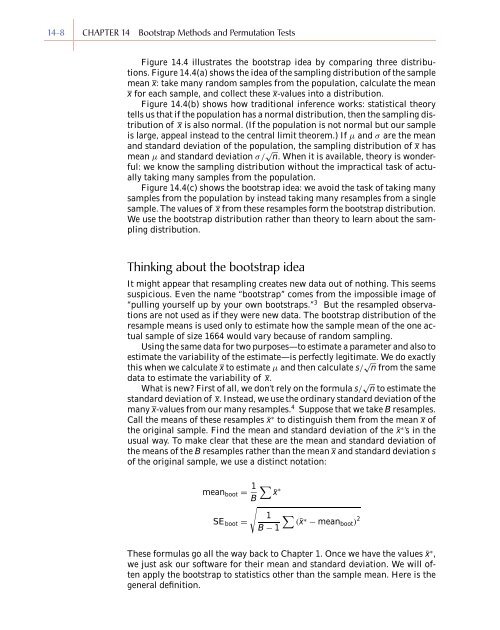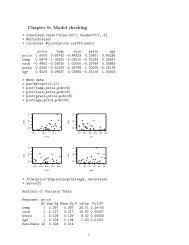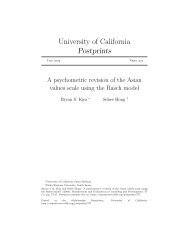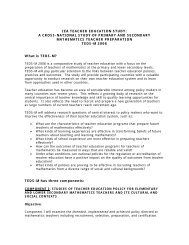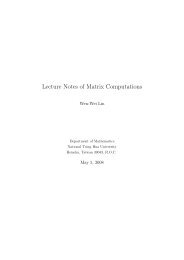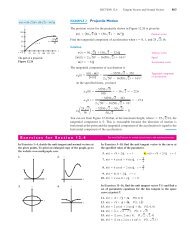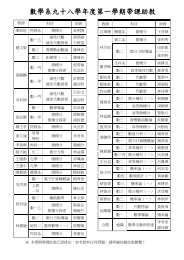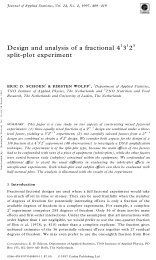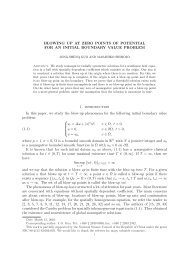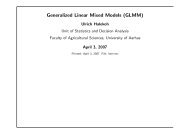Chapter 14 - Bootstrap Methods and Permutation Tests - WH Freeman
Chapter 14 - Bootstrap Methods and Permutation Tests - WH Freeman
Chapter 14 - Bootstrap Methods and Permutation Tests - WH Freeman
Create successful ePaper yourself
Turn your PDF publications into a flip-book with our unique Google optimized e-Paper software.
<strong>14</strong>-8 CHAPTER <strong>14</strong> <strong>Bootstrap</strong> <strong>Methods</strong> <strong>and</strong> <strong>Permutation</strong> <strong>Tests</strong><br />
Figure <strong>14</strong>.4 illustrates the bootstrap idea by comparing three distributions.<br />
Figure <strong>14</strong>.4(a) shows the idea of the sampling distribution of the sample<br />
mean x: take many r<strong>and</strong>om samples from the population, calculate the mean<br />
x for each sample, <strong>and</strong> collect these x-values into a distribution.<br />
Figure <strong>14</strong>.4(b) shows how traditional inference works: statistical theory<br />
tells us that if the population has a normal distribution, then the sampling distribution<br />
of x is also normal. (If the population is not normal but our sample<br />
is large, appeal instead to the central limit theorem.) If µ <strong>and</strong> σ are the mean<br />
<strong>and</strong> st<strong>and</strong>ard deviation of the population, the sampling distribution of x has<br />
mean µ <strong>and</strong> st<strong>and</strong>ard deviation σ/ √ n. When it is available, theory is wonderful:<br />
we know the sampling distribution without the impractical task of actually<br />
taking many samples from the population.<br />
Figure <strong>14</strong>.4(c) shows the bootstrap idea: we avoid the task of taking many<br />
samples from the population by instead taking many resamples from a single<br />
sample. The values of x from these resamples form the bootstrap distribution.<br />
We use the bootstrap distribution rather than theory to learn about the sampling<br />
distribution.<br />
Thinking about the bootstrap idea<br />
It might appear that resampling creates new data out of nothing. This seems<br />
suspicious. Even the name “bootstrap” comes from the impossible image of<br />
“pulling yourself up by your own bootstraps.” 3 But the resampled observations<br />
are not used as if they were new data. The bootstrap distribution of the<br />
resample means is used only to estimate how the sample mean of the one actual<br />
sample of size 1664 would vary because of r<strong>and</strong>om sampling.<br />
Using the same data for two purposes—to estimate a parameter <strong>and</strong> also to<br />
estimate the variability of the estimate—is perfectly legitimate. We do exactly<br />
this when we calculate x to estimate µ <strong>and</strong> then calculate s/ √ n from the same<br />
data to estimate the variability of x.<br />
What is new? First of all, we don’t rely on the formula s/ √ n to estimate the<br />
st<strong>and</strong>ard deviation of x. Instead, we use the ordinary st<strong>and</strong>ard deviation of the<br />
many x-values from our many resamples. 4 Suppose that we take B resamples.<br />
Call the means of these resamples ¯x ∗ to distinguish them from the mean x of<br />
the original sample. Find the mean <strong>and</strong> st<strong>and</strong>ard deviation of the ¯x ∗ ’s in the<br />
usual way. To make clear that these are the mean <strong>and</strong> st<strong>and</strong>ard deviation of<br />
the means of the B resamples rather than the mean x <strong>and</strong> st<strong>and</strong>ard deviation s<br />
of the original sample, we use a distinct notation:<br />
mean boot = 1 ∑<br />
¯x<br />
∗<br />
B<br />
√<br />
1 ∑<br />
SE boot =<br />
(¯x∗ − mean boot ) 2<br />
B − 1<br />
These formulas go all the way back to <strong>Chapter</strong> 1. Once we have the values ¯x ∗ ,<br />
we just ask our software for their mean <strong>and</strong> st<strong>and</strong>ard deviation. We will often<br />
apply the bootstrap to statistics other than the sample mean. Here is the<br />
general definition.


